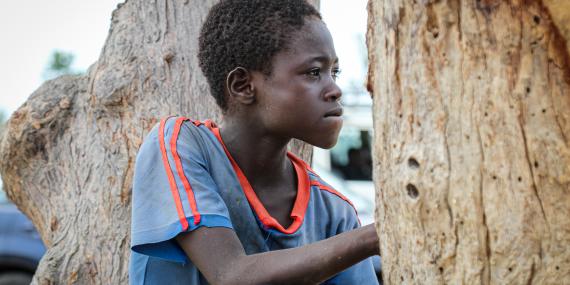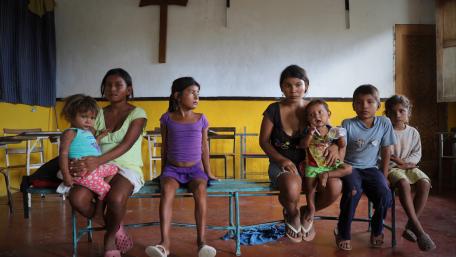N'Djamena, Chad
This year’s rainy season saw record-high rainfall in Chad, and in the Sahel as a whole. August 2020 saw numerous floods across most of the national territory: the central regions, the south, the east, Lac province and the capital, N’Djamena. OCHA/Federica Gabellini
The West and Central Africa region is beset with some of the world’s most acute and prolonged crises. Deep poverty, rapid population growth, climate change, chronically high food insecurity and malnutrition continue to drive extreme levels of vulnerability. The COVID-19 pandemic, related prevention measures and socioeconomic consequences are deeply affecting fragile communities. Conflict in the region’s hotspots persists or has worsened.
The compounded impact on the most vulnerable people is devastating and causing unprecedented, fast-escalating needs. Compared to last year, the number of people in need in the region has increased by 35 per cent. More than 1 person in 10 – over 60 million people – will require assistance and protection in 2021. Close to 1,000 humanitarian partner organizations are working across the region to respond to the most urgent needs of these people. Relief operations and local capacity require further scale-up, but funding is not keeping up.
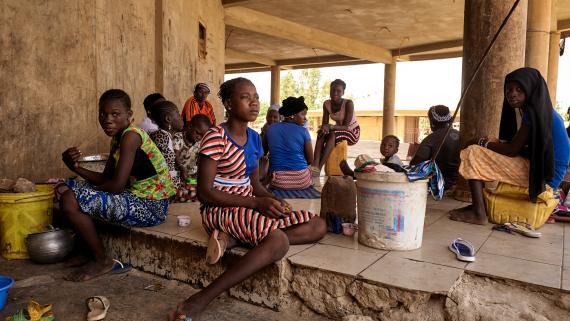
Gao, Mali
People who fled Mondoro are seen at the camp for displaced people of Gao on October 13, 2020. The displaced, who fled violent clashes in central Mali, arrived at the site at the end of 2018. According to the latest census, the site hosts around 600 displaced households.
OCHA/Michele CattaniClimate change and extreme weather events are a major driver of needs. Droughts are becoming more recurrent and severe, threatening livelihoods in vulnerable rural communities. Rainfall is irregular and increasingly unpredictable. In 2020, flooding has affected 2.3 million people in 18 countries of the region, resulting in the destruction of goods, land and livestock.
In conflict-affected regions, civilians are facing a dramatic protection crisis. Almost 13 million people had to flee their homes, 1.5 million more than one year ago. Insecurity and violence are threatening lives and livelihoods, increasing human rights violations, including sexual and gender-based violence, and jeopardizing social cohesion. Insecurity is also constraining humanitarian access, leaving communities without essential assistance and exposing aid workers to increased risks.
West and Central Africa: Overview of appeals (2021)
Violence and climate shocks also are the main drivers of a dramatic food crisis. Across the region, more than 40 million people are facing severe food insecurity. If conditions deteriorate, hunger hotspots in north-east Nigeria and Burkina Faso risk slipping into famine within months.
In the Sahel, forced displacement is at an unprecedented high, with 5 million people uprooted from their homes. More than 14 million people are acutely food insecure – two times more than one year ago. In the Central Sahel (Burkina Faso, Mali and western Niger) insecurity has rapidly deteriorated. Since 2018, the number of IDPs has risen twentyfold. In the Lake Chad Basin, incursions and violent incidents remain common, leading to additional displacement and needs.
In the Democratic Republic of the Congo (DRC) and the Central African Republic (CAR), long-running conflict and protracted crises continue to affect millions of people, with severe protection risks, forced displacement and high levels of food insecurity. In western Cameroon, violent conflict in the south-west and north-west regions has displaced more than 700,000 people.
Evolution of People in Need (2020 vs. 2021)
In 2021, the situation of millions of children, men and women affected by crisis in West and Central Africa remains critical. The trend in the Sahel points to further deterioration, with significant risk of spillover into coastal countries. The recent coup d’état in Mali and disputed elections in Guinea and Côte d’Ivoire have increased political and intercommunal tension. Upcoming elections in Burkina Faso, Niger, CAR and Chad will be set in contexts of insecurity. In Cameroon, solutions to the crisis in the anglophone regions are yet to materialize. In CAR, the peace agreement is regularly violated to the detriment of the protection of civilians, and new conflict hotspots in eastern DRC have caused more violence and forced displacement.
Further reading
Source: OCHA
Source: OCHA
Burkina Faso
Evolution of the context and crisis
Over the past two years, a grave protection-and-displacement crisis has emerged in Burkina Faso. It is grounded in insecurity and conflict, as non-State armed groups have increasingly targeted Government institutions and civilians with deadly attacks. As of October 2020, more than 1 million people have been displaced in less than two years.
The most severe impact is felt in already fragile parts of the country, where much of the population has long felt excluded from decision-making. Rising intercommunal tension, stigmatization between communities on the basis of ethnicity or other factors, and further erosion of trust in the Government linked to protection and human rights challenges were all exacerbating the situation prior to the COVID-19 pandemic, which has had a further detrimental impact. Furthermore, Burkina Faso experienced heavy rains and violent winds in 2020, affecting 106,000 people – most of whom were already displaced by conflict.
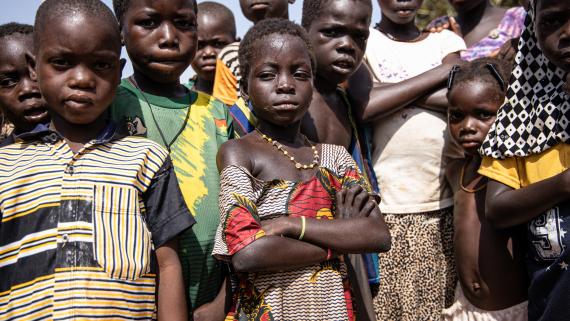
Kaya, Burkina Faso
The Central Sahel is the epicentre of one of the world's fastest-growing humanitarian crises. "We need to reverse this downward spiral with a renewed push for peace and reconciliation. We also need much more humanitarian aid. UN agencies and NGOs are on the ground to complement national humanitarian response efforts. With better funding, we can do much more," said UN Secretary-General António Guterres.
OCHA/Olympia de MaismontThe number of food-insecure people has nearly tripled over the past year, from 1.2 million to 3.3 million. For the first time in 10 years, the food security assessment (carried out in July 2020) classified two provinces of the Sahel region as being in emergency conditions (IPC 4), affecting 500,000 people. Of those people, 11,000 are at risk of catastrophic conditions (IPC 5). Global acute malnutrition rates are between 15 and 17 per cent, and severe malnutrition rates are 4 to 6 per cent among IDPs in several of the most affected and/or hard-to-reach areas of the Centre-Nord and Sahel regions.
Protection needs are increasing, with 2.1 per cent of IDPs living with disabilities, according to official sources. This is twice the national average. More than one third of children are at risk of recruitment by armed groups, forced labour or other protection concerns, and 1 per cent of IDP children are unaccompanied. Women and girls, who make up 54 per cent of IDPs, are at increased risk of sexual and gender-based violence by armed groups; many are forced to adopt negative coping mechanisms, including sex for survival.
Burkina Faso: emergency education in action
The director of this school in Kaya, Burkina Faso, welcomes children displaced by the ongoing violence, despite the little resources available. Overwhelmed by the increasing number of children, some classes are held outside. "One should not add another trauma to the existing traumas … but at least by accepting them we relieve the person, the parent and the student", he says.
OCHANearly 1 million people are affected by the closure or minimal functioning of 323 health centres. When the new school year started, 350,000 children remained without access to education due to the closure of over 2,200 schools. COVID-19’s effect on the economy exacerbates different vulnerabilities. An August 2020 study by the National Institute of Statistics and Demography indicates that one quarter of households do not have access to basic foodstuffs at a given time, while 10 per cent of employed people lost their jobs.
Humanitarian funding to Burkina Faso has more than doubled in 2020, but underfunding remains a significant constraint on humanitarian action, as needs and requirements continue to outpace funding and capacity. For 2020, just 55 per cent of required funding had been received by 25 November.
Projected situation in 2021 and beyond
In total, 3.5 million people in areas covered by the 2021 Humanitarian Response Plan (HRP) need multisectoral humanitarian assistance. This is a 60 per cent increase from the start of 2020. More than 1.3 million people require support to ensure their physical and mental well-being. Despite their incredible generosity and resilience, the Burkinabé people are increasingly unable to cope with this multidimensional crisis.
Evolution of needs and requirements (2016 - 2021)
People who need assistance are concentrated in six regions covered by the 2021 HRP: the Sahel, Centre-Nord, Nord, Boucle de Mouhoun, Est and Centre-Est (newly included in 2021). Among the most vulnerable groups are displaced people – both IDPs and refugees. Of those people, 19,000 are mainly Malian nationals; people in host communities, particularly where displaced people exceed residents; and people in areas where ongoing conflict and insecurity severely challenge humanitarian access. Women, girls, boys, the elderly and people living with disabilities experience the greatest concentration of needs.
Presidential and parliamentary elections will usher in a new Government in 2021. In the past, social upheaval has accompanied such transitions, increasing the risk of further challenges in access to basic social services such as health, education and public finance. The flooding and violent winds experienced in 2020, which severely affected already vulnerable households, are likely to return in 2021, according to meteorological information.
Response priorities in 2021
Given the worsening situation, further increases in response capacity are required in 2021, as well as concerted efforts to address disparities concealed by response-wide results. It will be essential to ensure greater capacity and coverage of rapid response action, secure high-quality and more durable materials, fulfil national and international standards, expand and standardize cash-based programming, and expand the coverage of protection referral systems and support services.
Understanding the severity of needs
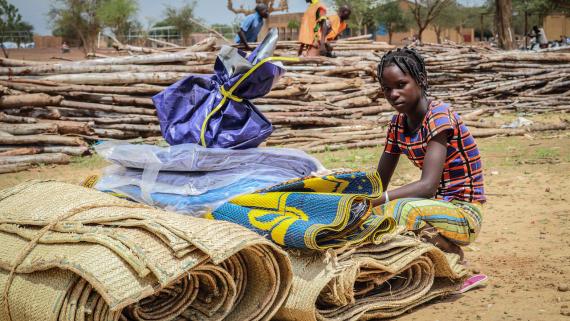
To identify gaps and disparities in the humanitarian response and guide humanitarian planning and decision-making, the Access Working Group in Burkina Faso has developed an innovative cross-analysis of data on the perceived severity of access constraints, humanitarian needs and humanitarian response. This has made it possible to systematically assess the appropriateness of response at the commune level (Admin 3) across the HRP coverage area. The analysis highlights two types of priority communes for advocacy and operational focus: communes experiencing severe access constraints, large amounts of needs, and insufficient response (access priorities), and communes with low to moderate access constraints, moderate amounts of needs, and insufficient response (nexus priorities). This systematic and periodic analysis, which informs the 2021 Humanitarian Needs Overview, is a decision-making tool that links access and needs assessments with quarterly response monitoring. This is in order to support strategic and operational decision-making by existing partners and to orient new partners opening in-country emergency response programmes. To access the online visual tool, click here: Combined overview of severity of access/needs and response assessment.
Norway Refugee Council/Innocent ParkoudaThe humanitarian community has collectively prioritized and supported enhanced engagement with and accountability to communities. Initial perception and satisfaction survey results show that affected communities prioritize food assistance, health care and adequate shelter among their most urgent needs, as well as strengthened access to basic social services, including WASH, education, and protection services and support. The results of the same survey indicate that inadequate amounts of available assistance, both in the number of people reached and the duration of support, are sources of dissatisfaction.
The continued increase in funding requirements in 2021 is due to larger target figures and increasing unit costs, including due to COVID-19-related measures. New areas of humanitarian action have been included, such as site management and new common services, such as UNHAS and logistics. Some clusters also need to make significant investments, such as those relating to shelter and NFIs, for the benefit of IDPs after more than two years of limited and immediate-use focused efforts.
Further reading
Source: OCHA
Source: Humanitarian Insight
Source: Financial Tracking Service
Cameroon
Analysis of the context, crisis and needs
Humanitarian needs in nine of Cameroon’s ten regions continue due to three concurrent crises affecting the country: the Lake Chad Basin conflict, the North-West South-West crisis and the Central African refugee crisis in the eastern regions. The required assistance ranges from immediate life-saving to protracted recovery.
In 2020, violence escalated against civilians in Cameroon’s Far North. Cameroon remains the country second most-affected by the Lake Chad Basin emergency. Ongoing hostilities have uprooted 560,000 people, an increase over 72,000 since October 2019. Armed attacks, abductions, including of children, and the looting and destruction of goods and infrastructure continue to cause physical and psychological trauma. Insecurity is exacerbating already limited access to basic social services such as education and health. Epidemics such as cholera, meningitis and measles are recurrent.
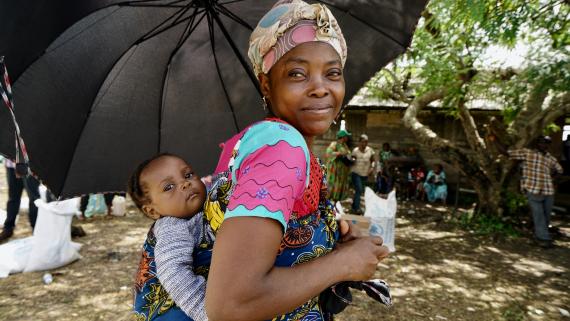
South-West region, Cameroon
A young mother at an OCHA-supported food distribution site in South-West Cameroon. At this distribution, each family received 5 kg of rice and 1 litee of palm oil. Many of those waiting for food aid now live in the forests and hills, away from the villages that were attacked.
OCHA/Giles ClarkeExcess rainfall since July 2020 has caused widespread flooding in five regions of Cameroon. More than 170,000 people were affected in the Far North region alone. The loss of livelihoods due to the armed conflict, the socioeconomic impact of the COVID-19 pandemic, as well as the destruction of houses, goods, crops and fields to the floods have resulted in a drastic increase in food insecurity. An estimated 630,000 people will be food insecure from June to August 2021, which is a 50 per cent increase compared to the same period in 2020.
What began as a political crisis in the South-West and North-West regions in 2017 has now become a significant, complex humanitarian emergency that displaced over 1 million people. People in rural and hard-to-reach areas are most affected because of limited or no access to medical, nutrition and WASH facilities and limited access to farmland due to insecurity. An estimated 700,000 children are out of school due to the crisis in the North-West and South-West regions. Students and teachers are killed, kidnapped, tortured, caught in crossfire, and subjected to arbitrary arrest and detention.
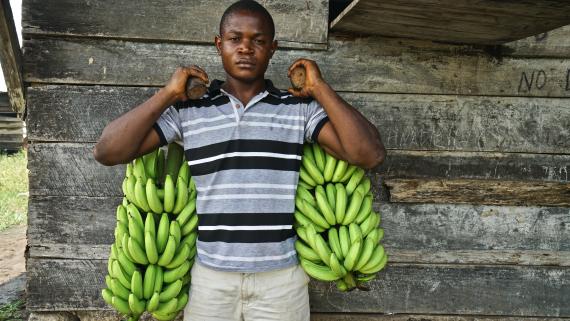
Ekona, Cameroon
A banana seller at the now-abandoned plantation town of Ekona, located a few miles from Buea. Just three years ago, Ekona Yard was a bustling fruit-processing centre packed with families who lived and worked in the vast surrounding banana-and-palm plantations. Since the crisis, the Government-owned plantations have been shut down as workers fled fearing attacks from separatists who oppose any kind of support to the Cameroonian Government.
OCHA/Giles ClarkeIn the Adamawa, East and North regions, Cameroon hosts 284,000 refugees from CAR. This is placing significant pressure on already limited natural resources and basic social services in host communities and exacerbating pre-existing vulnerabilities. Seventy per cent of the refugees have no formal education and 46 per cent have no source of income. Girls and young women are more likely to miss out on school, and they are particularly vulnerable to forced and early marriages and other forms of sexual exploitation.
Projected situation in 2021 and beyond
In 2021, 4 million people in Cameroon will need humanitarian assistance. In 2021, Cameroon will be the twelfth country in the world at highest humanitarian risk, with an INFORM index of 6.6 on a scale of 10. The trend is a clear deterioration of the humanitarian risk situation compared to 2020 (twenty-fourth country with a humanitarian risk index of 6 out of 10). Risks are particularly high in the Far North (7.3) North-West (6.5), South-West (6.2) and Est (6.1) regions. The highest risks are linked to conflicts, epidemics and floods. The security situation is expected to continue to deteriorate in the Far North, North-West and South-West regions in 2021, with a conflict risk index of 8 for the Far North and North-West and South-West regions.
Evolution of needs and requirements (2016 - 2021)
Limited humanitarian access due to underfunding, insecurity and poor road infrastructure is also projected to remain a key impediment to reaching people in need. Access by relief organizations will become increasingly more complex and dangerous as security deteriorates and humanitarian organizations are increasingly targeted by non-State armed groups.
Response priorities in 2021
The 2021 Humanitarian Response Plan will prioritize the most vulnerable 2.4 million people based on an analysis of the severity of needs across sectors, with a financial requirement of $360 million. In addition to meeting the most urgent needs, the approach taken in Cameroon recognizes that humanitarian needs are exacerbated by underlying structural causes. When and where appropriate, response activities are planned in complementarity with development and State actors to maximize impact, particularly in geographic areas, boosting the contribution of humanitarian action towards collective outcomes and achieving the SDGs. Protection remains a priority in the humanitarian response in Cameroon.
Bringing protection and gender to the fore
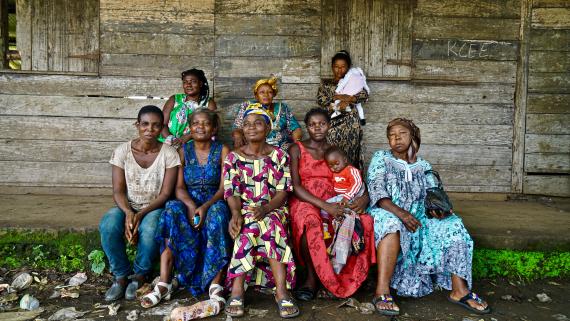
The humanitarian country team (HCT) in Cameroon has developed – separate, but complementary – roadmaps on the centrality of protection and on gender in humanitarian action. These two roadmaps are part of the first initiatives on this regard in different humanitarian contexts. These two year-long plans (2021-2022) articulate the collective results that the HCT, and the humanitarian community more broadly, aim to achieve and will be held accountable to. The two roadmaps will help the humanitarian operations to increase the quality and efficiency of its response, in line with the IASC gender and protection policies. Thanks to evidence-based analysis and adapted programmes, it is expected that protection and assistance needs will be appropriately addressed. Progress in achieving agreed results will be regularly monitored by the HCT, with support from the protection and the gender senior advisers supported respectively by the ProCap and GenCap projects.
OCHA/Giles ClarkeFurther reading
Source: OCHA
Source: Humanitarian Insight
Source: Financial Tracking Service
Central African Republic
Analysis of the context, crisis and needs
Despite the signing of the Political Accord for Peace and Reconciliation (APPR) in February 2019, the security situation in the Central African Republic (CAR) remains highly volatile. A continued rise in armed groups’ activities, violent confrontations over the control of natural resources, and intercommunal conflict, including transhumance-related conflict, have further eroded the population’s capacity to sustain multiple shocks. One in four Central Africans is displaced, either within or outside CAR. As of September 2020, almost 641,000 people are internally displaced, an 8 per cent increase compared to the same period in 2019.
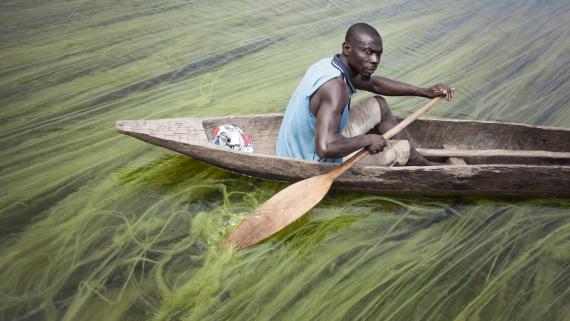
Mobaye, Central African Republic
This delegate for the displaced fishermen in Mobaye is about to leave for work, in Longo Island. Like other villages along the river, it has become a refuge for fishermen of the Basse Kotto Prefecture. They fear the armed groups who ransom, kidnap and force them to become combatants.
AFP/Florent VergnesThe COVID-19 pandemic has inflicted a devastating blow to the economic sector of a country already ranked second to last on the Human Development Index (HDI). COVID-19 restrictions and confinement measures have also increased protection risks. From April to June, the number of minors suffering from GBV increased significantly in Bangui. The closure of schools exposed hundreds of thousands of children to additional risks of recruitment into armed groups and the worst forms of labour, notably in mines. One GBV case per hour is recorded through the VBGIMS system, which covers only 42 per cent of the territory. The number of GBV cases recorded doubled in the capital, Bangui. The secondary impacts of COVID-19, food insecurity and malnutrition have spread to urban centers, such as Bangui and Bimbo.
Further deterioration has taken place in the socioeconomic context and is near collapse, severely affecting the prices of basic commodities, the labour market and households’ purchasing power at a time when the median cost of the Survival Minimum Expenditure Basket increased by 10 per cent.
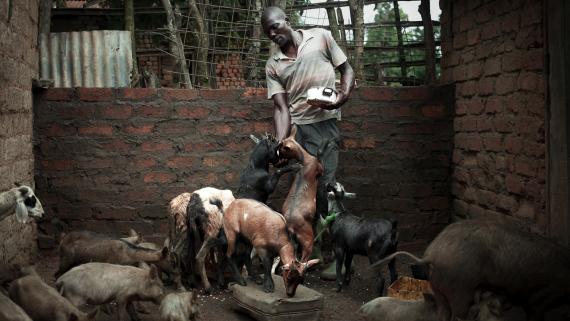
Bambari, Central African Republic
A former combatant in Bambari feeds his animals. He laid down his weapons in favour of animal husbandry. His farm is called Kekereke ti yé,which means ‘Our Future’.
AFP/Florent VergnesThe impacts of devastating floods in 2019, which affected 100,000 people, are still being felt in the capital. Thousands of people remain in displacement sites and thousands more are seeking shelter from this year’s torrential rains. As of November 2020, more than 24,000 people have been affected by floods caused by climatic change. Areas with a high concentration of IDPs are the most prone to epidemics, such as measles and waterborne diseases. Only one in three Central Africans has access to safe and drinkable water and sanitation facilities.
CAR is one of the world’s most dangerous countries for humanitarian workers, with more than one incident against humanitarian workers recorded each day. From January to October 2020, 344 security incidents were reported, which is a 42 per cent increase compared to the same period last year.
Projected situation in 2021 and beyond
An estimated 2.8 million people need humanitarian assistance, including 1.9 million people with severe needs. This represents the highest severity in the past five years. With no improvement in the security and structural drivers of the crisis and the emergence of new crises and hotspots, a sharp deterioration of key humanitarian indicators have been recorded. In the projected situation, 2.3 million people are food insecure, with 525,000 people in IPC Phase Four. Overall, at the intersectoral level, 52 sub-prefectures have reached severity threshold 4, and 20 sub-prefectures have reached severity threshold 3.
Evolution of needs and requirements (2016 - 2021)
With a score of 7.8, CAR ranks fifth in the world in terms of risk level, according to the INFORM 2021 index. This is due to the high risk of conflict, socioeconomic vulnerabilities and lack of human capital. CAR is classified as the world’s most vulnerable country to COVID-19. This is due to poor access to WASH structures, combined with household economic vulnerability and insufficient health coverage. The country is also experiencing heavy rains, with devastating consequences in bordering areas with Chad and Congo and in the capital, Bangui. Additional risks include the resurgence of Ebola in neighboring DRC and the presidential elections on 27 December 2020. Outbreaks of violence would likely result in more displacement and a further surge in humanitarian needs.
Response priorities in 2021
The humanitarian community assisted 1.4 million people between January and September 2020. These people comprised 78 per cent of the 2020 HRP targeted population, including those in hard-to-reach areas. Humanitarian actors were able to reach more people in 2020 compared to the previous year. This was despite an increasingly volatile security environment, logistical constraints such as dilapidated roads and bridges, and the absence of State services outside the capital. Three-quarters of beneficiaries have reported feeling safe accessing humanitarian assistance and are comfortable filing complaints with aid providers.
Placing the affected people at the heart of a principled response
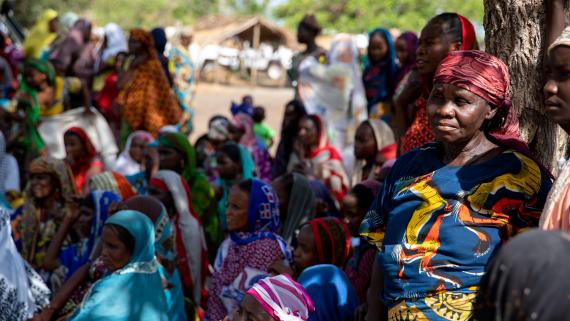
In 2020, the humanitarian community made an ambitious commitment to ensure that people remain at the heart of the response. Three poles of action were identified: protection, accountability to affected people and provision of services to communities. The humanitarian response took a qualitative leap by further involving the affected population in decisions having a directly bearing on them. Consultations with 16,000 households took place in all the country’s sub-prefectures, including through the Multi-Sector Needs Assessment in collaboration with REACH and Ground Truth Solutions. Communication and community engagement related to the COVID-19 response have adapted to information needs, including to debunk widespread rumors about the virus.
OCHA/Adrienne SurprenantIn 2021, humanitarian partners will further scale up integrated and multisectoral response approaches. This includes strengthened efforts to protect and assist the most vulnerable, including people living with disabilities, and women, girls and boys who are at risk of GBV. Better understanding of the barriers faced by people with disabilities and ensuring their full inclusion in targeting exercises will be prioritized, given that 57 per cent of people with disabilities reported not being able to access services. Improving feedback mechanisms will also be a priority, as 76 per cent of the affected civilians interviewed reported not knowing how to file a complaint.
Consultations to ensure accountability to affected populations will continue to be prioritized. Humanitarian partners will also continue their efforts to provide emergency assistance to communities in hard-to-reach areas through a conflict-sensitive access strategy and flexible, localized response mechanisms. Preparedness activities and response efforts will be a priority, due to the growing impact of climatic shocks. In the spirit of the Nexus, humanitarian actors will seek complementarity with durable solutions projects, social protection schemes and disaster risk reduction programmes in areas of convergence.
Further reading
Source: OCHA
Source: Humanitarian Insight
Source: Financial Tracking Service
Chad
Analysis of the context, crisis and needs
In 2020, Chad was affected by growing insecurity within its borders and within neighboring countries, economic fragility intensified by the COVID-19 pandemic, a precarious health context, and the impact of destructive climate-related events. The pandemic’s socioeconomic impact exacerbated pre-existing vulnerabilities, including of people – many of whom are women – working in the informal sector. The context was marked by the closure of borders, a collapse of the oil price, a rise in food prices and initial paralysis of the economic fabric, including high levels of unemployment for several months.
The security situation continued to be of concern in Lac province, including clashes between non-State armed groups and the Chadian Army and the declaration of a ‘no-go zone’ for civilians. As a result, the number of IDPs in that province increased to 336,000 – a 98 per cent rise compared to 2019. In southern and eastern Chad, some 480,000 refugees from the Central African Republic (CAR) and Sudan still depend on humanitarian assistance. Nearly 20,000 new refugees arrived in eastern Chad in 2020 due to the persistence of intercommunal clashes in Darfur. Intercommunal conflict between farmers and herders has also continued, particularly in the south.
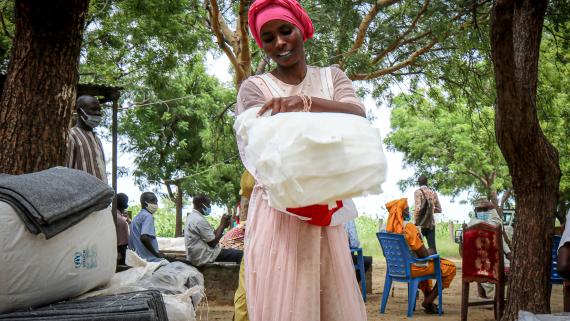
N’Djamena, Chad
A group from the Chadian Red Cross, helped by local volunteers, distribute non-food items to assist flood-affected people. This year’s rainy season saw record-high rainfall in Chad and in the Sahel as a whole. Floods destroyed 5,250 houses and killed 10 people. Those affected have sought refuge in their own neighbourhood or those nearby. Some people are hosted by family members but many remain homeless.
OCHA/Federica GabelliniHeavier floods compared to those in 2019 resulted in significant livelihood losses for farmers and herders, especially in the center, east and south, affecting some 388,000 people. For the first time since 2012, the capital was also severely affected by excessive rainfall. Rivers then burst their banks. Some 35,000 people required assistance.
The socioeconomic impact of COVID-19 affected the food and nutrition situation of the most vulnerable people. In 2020, the number of severely food insecure people remained 1 million. According to the preliminary results of the November food security assessment (Cadre Harmonisé), 2 million people now need livelihood support. The prevalence of acute malnutrition continues to rise, with 18 out of 23 provinces in an alarming nutritional situation. At the national level, GAM prevalence is 12.9 per cent, of which 2.9 per cent is in its severe form (SAM). Almost 2 million people are affected by health emergencies, the most vulnerable of whom are children under 5 years of age, pregnant and breastfeeding women, people with disabilities and the elderly. This situation is largely explained by the poor access to basic social services worsened by the pandemic, but also by the increase in endemic and epidemic diseases, notably malaria, measles and a new outbreak of chikungunya.
Projected situation in 2021 and beyond
Chad will remain affected by the political and security dynamics in neighboring countries. The active presence of non-State armed groups in northern CAR will, for the time being, slow down the potential return of CAR refugees from southern Chad. However, political developments in Sudan might lead to the gradual return of the Sudanese refugees in eastern Chad. In contrast, the presence of non-State armed groups in Lac province and military counteroperations are likely to cause further displacements. Instability in Libya has led to new waves of migrants returning to northern Chad.
Evolution of needs and requirements (2016 - 2020)
The consequences of climate change, especially droughts and floods, will affect agrosylvopastoral production, with negative impacts on food security and malnutrition rates. Access to basic social services, particularly health services, will remain challenging, especially with the persistence of epidemics such as cholera and measles, the lack of adequate health care, and the high prevalence of certain diseases, especially malaria. The persistence of COVID-19 could further worsen the living conditions of the most vulnerable people.
Response priorities in 2021
In 2021, the humanitarian response will remain guided by the established multi-year 2017-2021 strategic framework and its goals: to save and preserve life and dignity through multisectoral and integrated emergency assistance; to reduce vulnerability by building resilience; and to contribute to the protection of the most vulnerable populations and strengthen accountability to affected people.
Within this, 2021 response priorities and approaches will promote an integrated approach, with an increased number of defined multisectoral strategies, including for refugees, and it will reinforce complementarity between humanitarian and development action to achieve collective results. In this context, strengthening and empowering Government leadership is a priority, as is promoting durable solutions for displaced people (refugees, returnees and IDPs).
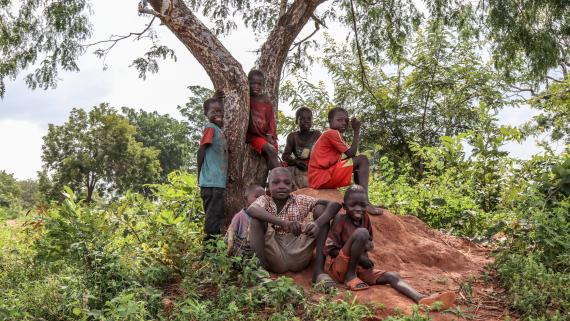
Dodinda, Chad
Children tending cattle in Dodinda, a small village on the outskirts of Moundou. For many Chadian children, the idea of attending school is beyond the realm of possibility. Recently introduced tuition fees - 2,500 CFA francs ($4.20) per year - make it challenging for parents to cover expenses and send their children to school.
OCHA/Federica GabelliniPlanning will be based on, inter alia, the specific vulnerabilities of women, girls, boys, children and people with disabilities. It will mainstream protection concerns and respond to the humanitarian impact of the COVID-19 pandemic. The centrality of protection and accountability to affected populations will be reinforced through community-based approaches to prevent protection risks, respond to the most urgent protection needs, including for GBV survivors, and assure fundamental human rights. Emergency preparedness, response and risk reduction measures remain of vital importance to mitigate the humanitarian consequences of climate change. The use of cash-transfer modalities, based on a survey of market availability and accessibility, will be further reinforced.
The humanitarian community is currently completing its analysis of people in need of assistance in 2021, and of the most vulnerable to be targeted for response. Final figures are pending formal completion of the Cadre Harmonisé process, which will reflect the projected impact on food insecure people from unfavorable climate effects, including droughts and floods and the socioeconomic impacts of the pandemic. Figures will also include the increased number of people displaced due to insecurity in Lac province.
Further reading
Source: OCHA
Source: Humanitarian Insight
Source: Financial Tracking Service
Democratic Republic of the Congo
Analysis of the context, crisis and needs
In the Democratic Republic of the Congo (DRC), violent conflict, epidemics and natural disasters continue to compound and exacerbate existing vulnerabilities. These include high levels of poverty, weak public infrastructure and limited-service delivery. Disputes over land and mineral resources continue to drive conflict dynamics and displacement. In 2020, armed conflict further intensified in Ituri and some parts of the Kivus.
DRC remains home to the largest IDP population in Africa, with 5.2 million displaced people. A total of 1.7 million people displacements took place in 2020. The country also hosts some 529,000 refugees from neighbouring countries. Almost 21.8 million people currently face severe acute food insecurity, the highest absolute number ever recorded worldwide. Some 3.4 million children under age 5 are acutely malnourished.

Libenge, Democratic Republic of the Congo
These inhabitants of a village bordering the Oubangui River took refuge in the forest to flee the floods. Children are very vulnerable to mosquito bites. In Libenge, torrential rains caused the sudden flooding of the Oubangui River. This rise in water has invaded practically all the villages located along the bank.
OCHA/Alioune NdiayeCommunicable disease outbreaks continue to add to the complexity and gravity of the situation: while the tenth Ebola epidemic in the eastern region ended in June, a new Ebola outbreak has emerged in Equateur, which is an extremely fragile area. Thanks to the combined efforts of the Government and the humanitarian community, the worst national measles epidemics ended in August 2020. However, measles, as well as cholera, remain a serious concern (415 deaths on 32,375 cases and 184 deaths on 4,283 cases, respectively, in 2020). In March the first COVID-19 infection was recorded, and to date11,329 cases and 308 deaths have been confirmed. Due to extremely limited testing capacity, the full extent of the pandemic is likely to be larger. But the economic impact is evident: falling commodity prices are triggering a currency devaluation, which in turn is driving up prices.
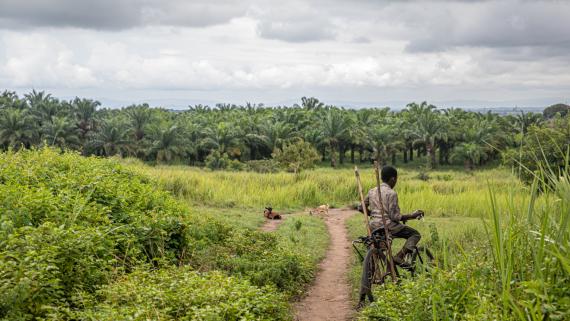
Tabac, Democratic Republic of the Congo
A boy rids his bike in the jungle, near the Cholera Treatment Unit in the town of Tabac, Tanganyika province. The project has been financed by the DRC Humanitarian Fund.
OCHA/Alioune NdiayeThe volatile security situation, particularly in eastern DRC, continues to hinder access to affected people, as does poor infrastructure. Humanitarian actors in several provinces have reduced movements or temporarily suspended their activities on multiple occasions due to incidents. At least 249 security incidents directly affecting humanitarian personnel or assets have been reported since the beginning of 2020.
Projected situation in 2021 and beyond
Conflicts are expected to persist. The dynamics of these conflicts will remain complicated as a result of national and provincial political dynamics. The reconfiguration of the UN Stabilization Mission in the Democratic Republic of the Congo (MONUSCO) could also be a factor influencing the situation and local contexts. Population displacement and protection incidents, especially in eastern DRC, are expected to persist. IDPs, returnees and host communities continue to be the most vulnerable. The evolution of epidemics or new disease outbreaks and potential natural disasters, such as floods, could potentially aggravate the situation further.
Evolution of needs and requirements (2016 - 2021)
The number of people who need humanitarian assistance in DRC has increased from 15.6 million in 2020 to 19.6 million in 2021. This is being driven by intensified conflict in some areas, increasing severe food insecurity, COVID-19 and the Ebola outbreak in Equateur province. The impact of the latter is expected to significantly decrease over the coming months but would remain under surveillance.
Structural underdevelopment and humanitarian crises will continue to limit people’s access to essential goods and services, negatively impacting their coping mechanisms and capacity for resilience.
Response priorities in 2021
By the end of 2020, the humanitarian community expects to have reached 6.6 million people. The 2021 response strategy will focus on addressing five critical issues: population movements, food insecurity, malnutrition, epidemics and protection. In 2021, humanitarian partners will aim to assist 9.6 million of the most vulnerable people in DRC, with an estimated financial requirement of $1.98 billion. The targeting methodology has been further strengthened through the intersectoral approach and severity analysis to ensure that the most severe needs are prioritized.
Analyzing the impact of COVID-19
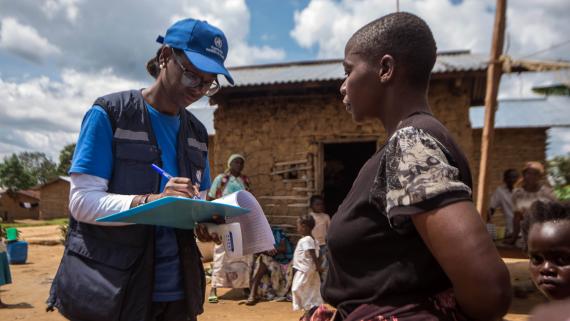
An analysis of COVID-19 impact was undertaken to evaluate the epidemic’s influence on humanitarian needs and operations in DRC. When the epidemic emerged in the country in March 2020, a rapid survey, was launched and responded to by 149 humanitarian partners. This analysis of the immediate impact of preventive measures on humanitarian activities showed that 80% of partners had been directly affected and had to reduce movements or presence in the field. The results were used for advocacy to ensure access to areas most affected by the humanitarian crisis. Six months later, a second survey was launched to update the analysis. The analysis was more comprehensive and focused on COVID-19 impact on (i) humanitarian operations (access, operational capacities) (ii) services & systems (access to health, WASH, nutrition, education & protection services) (iii) persons (protection incidents, food insecurity, coping mechanisms). 234 organizations participated in the survey which was completed by a qualitative analysis of secondary data available on the specific impact of COVID-19 epidemic in DRC. It contributed to strengthen the intersectoral analysis of needs in the framework of the HNO 2021.
WHO/Junior KannahFollowing the severity analysis, the key geographical focus of the humanitarian response will be on Ituri, North Kivu, South Kivu, Tanganyika and the Greater Kasai area. These locations have an overlay of crisis drivers and deepening humanitarian needs.
Humanitarian partners will work to achieve objectives by delivering targeted, multisector assistance. Throughout the response they will mainstream key cross-cutting approaches, which include AAP, prevention of SEA, mitigation of GBV risk in programme implementation and inclusion of people with disabilities. Building on progress made since 2019 (such as proposed collective outcomes), humanitarian actors will continue to enhance and promote the Nexus approach to reduce vulnerabilities.
Further reading
Source: OCHA
Source: Humanitarian Insight
Source: Financial Tracking Service
Mali
Analysis of the context, crisis and needs
In 2020, the humanitarian crises in Mali worsened due to the immediate multifaceted effects of conflict and violence, including inter and intracommunal conflicts, radicalized armed groups and criminality. The number of vulnerable people who need assistance increased due to pervasive poverty, the COVID-19 pandemic and the chronic effects of climate change. Mali also underwent a political crisis culminating in the Army ousting the Government, resulting in an 18-month transition period as of September. The conflict and the accompanying humanitarian needs expanded from Mali's Liptako-Gourma region to the Kayes, Koulikoro and Sikasso regions in the south and west.
The number of food-and-nutrition insecure people reached 1.3 million people during the lean season of June-August 2020, which is an increase of more than 200 per cent compared to the same period in 2019. This is due to the volatile security and transitional political context, combined with the weak presence of Malian regional authorities and technical services. Additionally, 2.4 million people currently need support to protect their livelihoods.
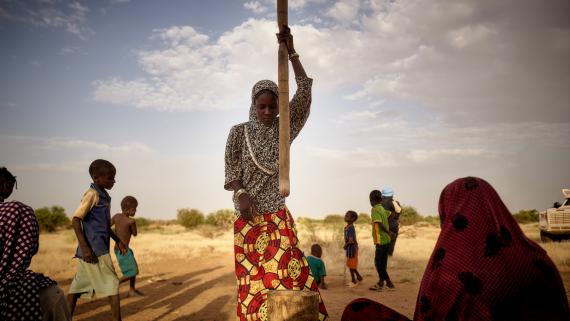
Bagoundié, Mali
A displaced woman crushes millet in the informal camp in Bagoundié, 8 km from Gao. The camp hosts 300 households of Fulani, who fled their homes in Tessit, near Ansongo, due to the ongoing conflict and clashes between armed groups
OCHA/Michele CattaniThe growing instability led to a surge in internal displacement. As of the end of August 2020, close to 290,000 people were internally displaced. This is four times more than in early 2019 and adds 100,000 people since August 2019. UNHCR reported that the number of Malian refugees and asylum seekers in neighbouring countries increased from 138,402 to 141,676 between September 2019 and July 2020. Meanwhile, 84,000 Malian refugees returned to Mali over the same period due to the insecurity.
The protection of vulnerable groups remains worrisome, with 4,411 cases of gender-based violence (GBV) reported since January 2020, mainly by women (98 per cent), of whom 61 per cent are girls. Civilians are increasingly exposed to risks on the main roads due to improvised explosive devices (IEDs) in central Mali. From January to September 2020, IEDs killed 181 civilians. This is on par with the past two years: IEDs claimed 222 casualties in 2019 and 249 casualties in 2018.
A total of 1,261 schools remained closed due to insecurity in the center and north, depriving 338,700 children of their right to education. Access to safe drinking water remains problematic, with less than one in two people having access to safe drinking water in Gao and Kidal. Five per cent of IDPs have safe access to water, which is below the national average of 68.8 per cent.
Mali: keeping children safe and learning
A young displaced woman volunteers in a child-friendly space in an IDP camp in Gao, northern Mali. Her commitment to keeping children connected to education makes a difference on the lives of hundreds of children displaced by the ongoing violence.
OCHAIn conflict-affected areas, 23 per cent of health facilities are not functioning and primary health-care services remain limited. As of 8 November 2020, 3,706 COVID-19 cases had been confirmed in 38 health districts across 9 regions, including 137 deaths (3.7 per cent case-fatality rate) and 2,828 patients cured. In addition, the socioeconomic consequences related to COVID-19 are likely to have a long-term socioeconomic impact for the poorest households.
Floods caused significant damage to crops, equipment, housing, grain stores and livestock. According to Government figures, as of 30 September 2020, floods affected 11,019 households (80,760 people), including 5,400 IDPs, in the Koulikoro, Menaka and Segou regions.
Faced with a public health emergency, natural disasters and fragile security, humanitarian partners (with 45 per cent of financial requirements resourced available) will reach 2.6 million people out of the targeted 5.5 million by December 2020. This is an increase of approximately 11 per cent from the 2.35 million people reached by 30 September 2020.
Projected situation in 2021 and beyond
Given the deterioration of the protracted humanitarian context, 2021 is likely to see humanitarian needs increase. Operational challenges related to humanitarian access, protection and the preservation of humanitarian space will dominate advocacy and coordination efforts to reach people in need. Under the current circumstances, IDPs have no short- or medium-term prospect for return. Substandard living conditions, food insecurity, malnutrition and health hazards will rise among an increasingly vulnerable population who resort to negative coping strategies, affecting women, girls and people with disabilities.
Evolution of needs and requirements (2016 - 2021)
Despite favourable rainfall for the 2020 agricultural season, humanitarian partners identified a record 7.1 million people who need humanitarian assistance in 2021 out of 13.5 million crisis-affected people. Food insecurity is likely to continue due to the access constraints to arable land because of ongoing conflict in central Mali. Sustained high market prices for cereals and livestock, as well as COVID-19-related restrictions that include supply chain disruptions, are among the underlying factors worsening the food security situation. Approximately 188,000 Malian children under 5 years of age are expected to be affected by severe acute malnutrition in 2021, while an estimated 1.2 million people are exposed to the risk of waterborne diseases.
In response to the pandemic, resources were reallocated from basic health-care services. This has negatively impacted health-care services such as primary health care, nutritional services and vaccinations.
Response priorities in 2021
For 2021, the Malian humanitarian community renews its commitment to strengthen its operational capacities to meet the needs of 5.8 million people targeted by the 2021 Humanitarian Response Plan (HRP). The overall estimated budget for humanitarian planning is $498 million. This is for sectoral, intersectoral, and multisectoral interventions covering the humanitarian consequences of the crisis related to life-saving responses, strengthening basic social services, assuring the protection of the population and promoting resilience. These interventions include three thematic pillars in line with the three-year strategic objectives: food and nutritional security; health and WASH; and protection, education and shelter/non-food items, as adopted in 2020.
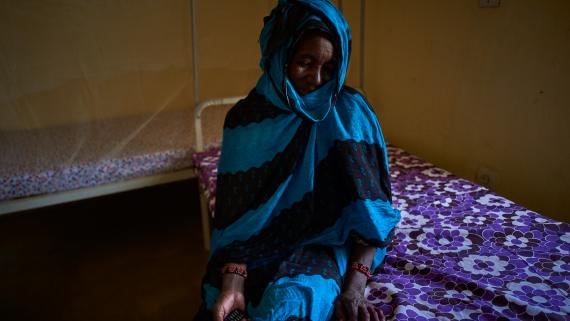
Gao, Mali
A displaced woman who denounced a case of GBV against her daughter during their displacement, at the One Stop Center in Gao. In the Central Sahel, more than 1.5 million people have been forced from their homes by violence in the last two years. GBV has spiked, millions of children are out of school, and basic health and social services are lacking.
OCHA/Michele CattaniThe pandemic has exacerbated protection risks and threats including GBV, and increased stigma and discrimination towards IDP. The centrality of protection remains crucial in the humanitarian response for Mali in 2021. Cross-cutting issues such as gender, accountability, SGBV and PSEA are also crucial.
To reduce vulnerability, strengthen resilience and improve the protection of the environment, collective outcomes must be identified based on strengthened coordination and complementarity between humanitarian, development and peace interventions. This includes social cohesion activities and the socioeconomic empowerment of affected populations.
Interventions integrate COVID-19 mitigation measures to protect staff, communities and partners involved in humanitarian programmes.
Further reading
Source: OCHA
Source: Humanitarian Insight
Source: Financial Tracking Service
Niger
Analysis of the context, crisis and needs
2020 has been marked by persistent and increasing insecurity in certain border areas between Niger and neighbouring Nigeria, Mali and Burkina Faso. The activities of non-State armed groups (NSAGs) in the regions of Diffa, Tillabéri and Tahoua and the recurrent incursions of NSAGs from bordering countries caused population movements, particularly in the Tillabéri and Maradi regions. As of 30 September 2020, the number of people on the move (IDPs, refugees and returnees) was estimated at more than 530,000, which is an increase of 21 per cent in comparison to 2019. In the regions of Diffa, Maradi, Tillabéri and Tahoua alone, the number of IDPs increased by 37 per cent. Insecurity has led to the closure of 356 schools, affecting more than 33,500 children in Maradi, Tillabéri and Tahoua. The number of human rights violations also increased. Overall, 1,758 protection incidents were recorded as of 30 September. The number of recorded GBV cases increased by 133 per cent, from 1,399 in 2019 to 3,261 in 2020.
Flooding in Niger between August and September caused extensive damage. As of 20 October, 632,000 people (three times more than forecast by the Government) in 116 communes (44 per cent) across the country were affected by the destruction of more than 50,000 houses and over 18,000 ha of farming areas, and the loss of more than 15,000 small ruminants. These losses will weaken the livelihood conditions of already vulnerable populations.
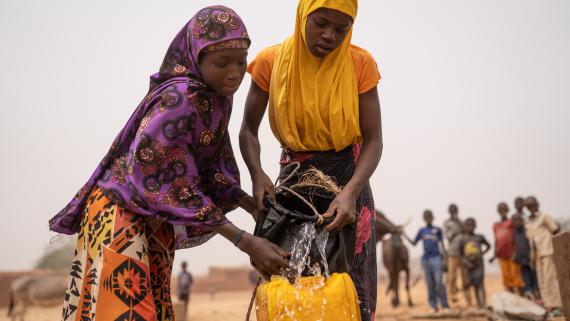
Gomozo, Niger
These two girls spend between four and six hours every day collecting water for their families. They take turns with other girls in the family, who pair up with a friend every morning before the sun is too strong and every afternoon before sunset. In Niger, as in many other countries on the African continent, collecting water takes up a colossal amount of time for women and girls. When water is not piped to the home, the burden of fetching it falls disproportionately on women and children, especially girls.
UNICEF/Juan HaroAs of 31 October, the COVID-19 epidemic has also impacted the daily lives of Nigeriens in 28 out of 72 health districts. Its impact has not been strong in terms of loss of human lives (69 deaths as of 31 October out of 1,220 people declared positive, i.e. a fatality rate of 5 per cent). However, its effects have been felt on the economic level. The mobility restrictions introduced by the Government to limit the spread of the virus restricted the population's access to necessary food items.
In addition to COVID-19, Niger experienced three other disease outbreaks, namely measles, vaccine-derived poliomyelitis virus type 2, and malaria. According to health authority records released in September 2020, measles affected 2,685 people, polio affected 5 people, and there were more than 2 million cases of malaria. Malnutrition and food insecurity are also major concerns, affecting more than 2 million people.
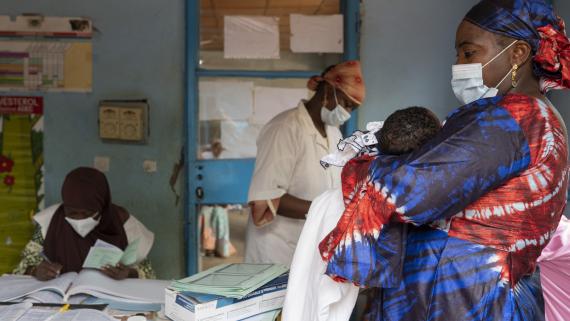
Niamey, Niger
A woman holds her son while waiting for him to be vaccinated, at Gamkalé health centre in Niamey. “Although I am still a little afraid to come to the centre, today I have come to vaccinate my son. I know it is important and I do not want him to miss [being vaccinated].” With the arrival of COVID-19, there has been a decrease in attendance at health facilities, prompting increased monitoring to detect the effects of the pandemic on routine immunization.
UNICEF/Juan HaroGovernment-imposed escorts due to insecurity have greatly contributed to restricting humanitarian access. In Tillabéri and Tahoua, more than six assessment missions were canceled between January and July for reasons linked to escort requirements, depriving several thousand affected people of much-needed humanitarian assistance. In October, more than 30,000 people were deprived of access to health-care services due to the closure of health centres in the districts of Ayorou and Banibangou in Tillabéri because of insecurity. The rehabilitation of hydraulic facilities could not take place in the Tillabéri region, depriving more than 12,000 people, living in 12 sites, of access to drinking water.
2020 was an unpredictable year. COVID-19 overturned the initial 2020 planning, leading to the revision of the HRP 2020 in July. The PiN was revised from 2.9 million at the beginning of the year to 3.7 million at the mid-year review, and the target increased from 1.8 million to 2.2 million during the same period.
Despite the low level of funding received (44 per cent of funds requested by 2 November 2020), the humanitarian community was able to assist 1.07 million people, or 49 per cent of targeted people. Food assistance was provided to 1,073,088 people, while 73 per cent of those targeted were able to benefit from temporary access to drinking water.
Projected situation in 2021 and beyond
The impact of this year’s flooding, localized droughts, COVID-19, as well as armed conflicts and NSAGs activities (including physical aggression and human rights violations), climate hazards, health and water challenges and malnutrition will increase the number of vulnerable people already living in precarious conditions. In light of this context, the number of people who need humanitarian assistance will most likely increase in 2021.
Evolution of needs and requirements (2016 - 2021)
Response priorities in 2021
In 2021, the focus will be on mitigating the impact of the various shocks on the livelihoods of the affected populations, but also on ensuring greater protection of affected communities. Thus in 2021, an estimated 2.2 million people will be targeted for humanitarian assistance. Despite the trend of increasing needs, this figure, which is almost the same as after the HRP revision in July 2020, is the result of better targeting by clusters (focus on people in acute need of assistance) and of improved synergy with development actors within the Nexus framework. For example, the food security cluster target was split between the National Plan of vulnerable populations, which covers the needs of 31 per cent of affected people, and the HRP, which covers the remaining 69 per cent. Since the average cost per beneficiary has not changed, the required budget for 2021 is estimated at $500 million.
Further reading
Source: OCHA
Source: Humanitarian Insight
Source: Financial Tracking Service
Nigeria
Analysis of the context, crisis and needs
The major crisis in Nigeria’s north-east persists unabated: the continuing conflict will still severely affect millions of people in 2021, subjecting them to displacement, impoverishment and threat of violence. The armed conflict has no clear end in sight. The Nigerian Armed Forces’ strategy (since 2019) of regrouping in ‘super camps’ has not guaranteed security and protection for nearby IDPs and other civilians. Prospects for displaced people’s safe return to their areas of origin are far from certain.
The operating environment remains extremely volatile, particularly in Borno State where all the major supply routes have become dangerous for civilians and specifically for aid workers, humanitarian cargo and assets. Humanitarian hubs and aid organizations’ offices have suffered regular attacks in 2020.
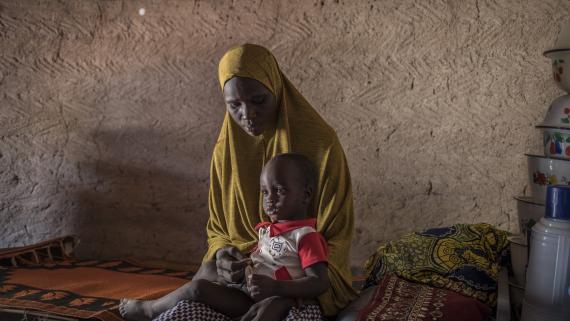
Garandiya, Nigeria
A mother holds her 19-month-old son in their home in Garandiya, north-eastern Nigeria. Pneumonia claims the lives of more than 800,000 children under 5 years of age every year. In 2018, Nigerian children made up the highest number of those who died, with an estimated 162,000 deaths. Children in poor areas are most vulnerable, often suffering from higher rates of malnutrition, exposure to unsafe water and sanitation facilities, and insufficient access to vaccinations and other affordable health services.
UNICEF/Siegfried ModolaProtection needs are formidable. Women and girls are under threat of violence, abduction and rape, for example when venturing outside the trenches that surround many IDP camps to collect firewood, though also within IDP camps. Gender-based violence is growing, as are forced and child marriage; women and girls still lack adequate protection and access to services. Desperation drives women to negative coping strategies such as exchanging sex for food and other necessities. These all drive greater maternal mortality, morbidity such as fistula, unwanted pregnancies, and girls dropping out of school. Displacement and returns impose high risk on separated and unaccompanied children. Adolescent males and boys risk forcible recruitment by armed groups or suspicion of association with armed groups by authorities.
The COVID-19 pandemic both deepens humanitarian needs and complicates the response. The Nigerian economy has suffered from the fall in global oil prices and from restriction measures to mitigate the pandemic, particularly intermittent border closures and the need to dedicate resources to curtailing the virus’ spread. The consequent impairment of livelihoods cascades down to loss of income and buying power, with acute effects on the already-vulnerable and food-insecure. Operationally, COVID-19 measures to keep humanitarian staff and beneficiaries safe consume time and resources. Conflict and insecurity have cut people off from their main means of livelihoods—agricultural lands. This causes major food insecurity in north-east Nigeria, which COVID-19’s effects on incomes have exacerbated: despite good crop yields, food insecurity is rising.
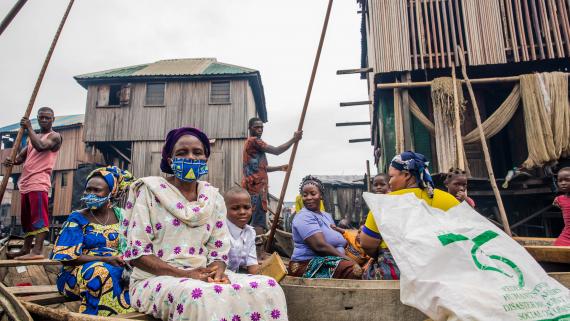
Makoko, Nigeria
A family travels home by boat after receiving food rations at a collection centre for the National Home Grown School Feeding Programme, in Makoko. The Federal Government of Nigeria and state Governments, with assistance from WFP, have rolled out programmes to supplement nutritional deficits for school children, which may arise from COVID-19-related school closures.
WFP/Damilola OnafuwaNonetheless solutions are sought for people caught in this crisis, many since 2009. State governments are increasingly committed to IDP returns: the Borno State Government in particular has set a target of all IDPs returning by May 2021. If most of the areas identified for return are highly insecure and inaccessible to humanitarian organizations, alternatives could be available and need further exploration—mainly resettlement in safer areas where there is enough land, or local integration alongside the cities and towns where they refuge. For the few areas that are relatively safe for IDPs who choose to return, a concerted package including timely durable-solution plans is now needed to ensure safe, voluntary, and dignified return. Essential services, firm livelihood prospects, basic infrastructure, civil administration to ensure rule of law, and humanitarian aid for the difficult first phases of return will all have to be delivered synchronously. For IDPs from areas not conducive to returns, humanitarians will advocate (and State governments have signalled some openness to developing) the alternative solutions—durable though not necessarily permanent—of local integration or resettlement. A focused initial exercise might point the way forward by crystallizing new joint working methods among government, national and local civil society, and the international community—in particular development, humanitarian and peace-building actors. Still, as solutions will be slow to arrive for most of the 1.9 million IDPs in need, the humanitarian community must continue to improve conditions in camps, including decongestion, and host communities.
Projected situation in 2021 and beyond
The thorough multi-sector needs assessment (MSNA) in mid-2020 plus other data and risk analysis project a 13% rise in people in need in 2021, from 7.9 million in 2020 to 8.9 million people in 2021. The slight reduction of IDPs and returnees in need is more than offset by a rise in needs of host communities, mainly due to COVID-19. Needs are multi-sectoral and vary in severity across areas and among the three affected groups of IDPs, returnees and host communities.
Evolution of needs and requirements (2016 - 2021)
Response priorities in 2021
Strategic, inter-sectoral focuses for 2021 can be grouped as: improve conditions and services in IDP camps; remedy acute food insecurity including in host communities; strengthen self-reliant livelihoods for IDPs in and out of formal camps; and achieve alternative and durable solutions on the limited scale likely to be feasible in 2021.
Because the needs are widespread, areas (and affected groups therein) with worse levels of severity are estimated as people in need. Within those, sectors target the people most in need, with gender sensitivity, up to the limit of a sector’s collective capacity to deliver. Prioritization of the most critical actions therein further sharpens the planned response. Better quantifying the Government’s humanitarian response will focus the HRP on true gaps.
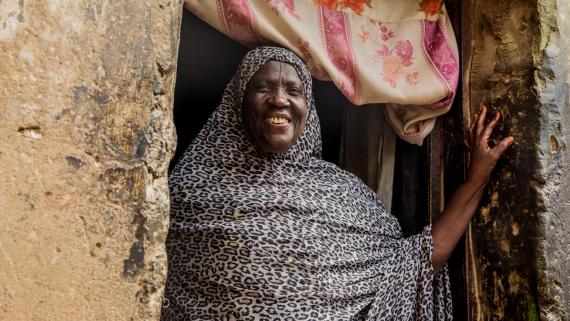
Kano, Nigeria
Kano is the capital of Kano State, the commercial nerve centre of northern Nigeria with 4 million mostly Muslim residents. The streets show no sign of the colourful festivities usually associated with Sallah celebrations. “We have never experienced this type of year,” says this 80-year-old resident. Her meager income selling soup spices disappeared because of lockdown. This left her unable to celebrate Sallah as she would have liked to.
WFP/Damilola OnafuwaLastly, the prospect of solutions for some affected people calls for synchronized humanitarian, development and peace-building actions in the nexus spirit, which this HRP will pursue concretely as opportunities arise in 2021.
Further reading
Source: OCHA
Source: Humanitarian Insight
Source: Financial Tracking Service
References
- Centre Africain pour les Applications de la Météorologie au Développement (ACMAD)
- 321,886 IDP (IOM, DTM, June 2020); 114,496 Nigerian refugees (UNHCR, September 2020; IOM DTM June 2020); 123,489 returnees (IOM, DTM, June 2020).
- Cadre Harmonisé, Octobre 2020.
- In October 2019, Cadre Harmonisé estimated 324,285 people to be food insecure from June to August 2020.
- 409,000 within the NWSW regions (MSNA, OCHA, August 2020); 361,000 returnees (MSNA, August 2020, OCHA) 302,000 to other regions (5,301 to Adamawa (MIRA, August 2019, UNHCR), 52,931 to Yaoundé, Center (MIRA, August 2020, CHOI); 80,925 to Littoral (MSNA, August 2020, OCHA); 162,726 to West (MSNA, August 2020, OCHA)).
- UNHCR, September 2020.
- Population movements commissions, Statistical data on population movements (September 2018 – August 2020).
- UNHCR, Refugees data as of the end of July 2020.
- IPC analysis, 18th cycle, current period (July – December 2020), August 2020.
- Nutrition Cluster data, as of the end of August 2020.
- WHO and Ministry of Health, Epidemiological data as of the end of October 2020.
- WHO and Ministry of Health, Epidemiological data as of the end of October 2020.
- INSO, UNDSS, OCHA, as of the end of September 2020.
- Provisional figures subject to change after the revision of the harmonized framework that sets the food security PIN.

